- Home›
- Healthy Living›
- International Yoga Day 2023- 6 Yoga Asanas That Will Help Womens To Regulate Hormones
International Yoga Day 2023- 6 Yoga Asanas That Will Help Womens To Regulate Hormones
By: Priyanka Maheshwari Mon, 19 June 2023 7:30:03
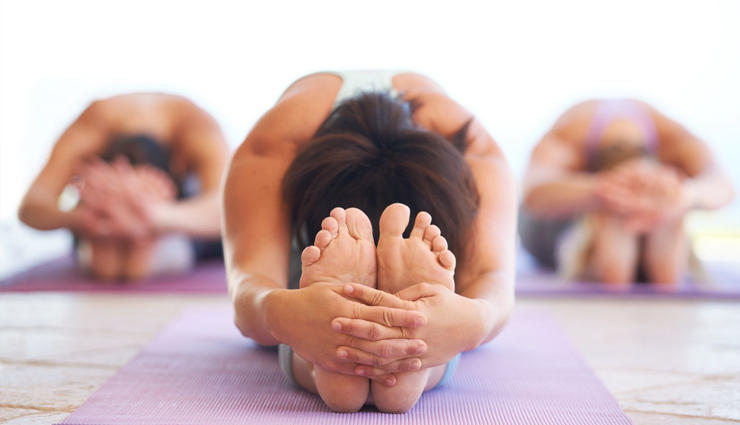
Regulating hormones in women is a crucial aspect of maintaining overall health and well-being. Hormones play a vital role in numerous bodily functions, including reproductive health, mood regulation, metabolism, and more. When hormones become imbalanced, it can lead to various physical and emotional symptoms, affecting a woman's quality of life.
Hormonal imbalances in women can occur due to several factors, such as stress, aging, certain medical conditions, lifestyle choices, and fluctuations during the menstrual cycle. Common hormonal imbalances include estrogen dominance, low progesterone, thyroid disorders, and polycystic ovary syndrome (PCOS).
It's important to note that hormone regulation is a complex process, and the appropriate approach may vary for each individual. Consulting with a healthcare professional, such as a gynecologist or endocrinologist, is essential to accurately diagnose hormonal imbalances and determine the most appropriate treatment or management plan. They can provide personalized guidance and recommend specific interventions based on an individual's unique needs.
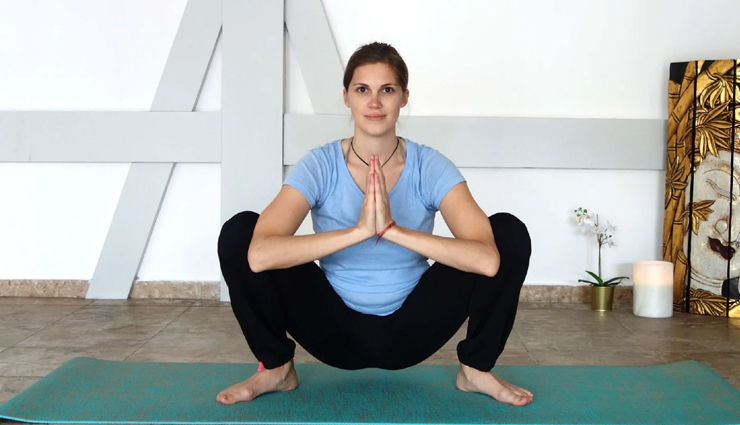
# Malasana or Garland Pose
Malasana, also known as Garland Pose or the Yoga Squat, is a grounding and hip-opening yoga pose that can help stretch the lower body, increase flexibility, and improve mobility. Here's a step-by-step guide on how to practice Malasana:
- Begin by standing at the top of your yoga mat with your feet slightly wider than hip-width apart. Turn your toes slightly outward, at around a 45-degree angle.
- As you exhale, start to bend your knees and lower your hips toward the ground. Aim to bring your hips lower than your knees, but if you have tight hips or limited mobility, it's okay to come to a comfortable depth.
- Bring your palms together at your heart center, pressing your elbows against the inner sides of your knees. Use your elbows to gently push your knees apart, creating space and opening in your hips.
- Lengthen your spine and keep your chest lifted. Try to avoid rounding your back. If you find it challenging to keep your heels on the ground, you can place a folded blanket or a yoga block under your heels for support.
- Relax your shoulders away from your ears and find a comfortable gaze straight ahead or slightly upward.
- Hold the pose for several breaths, allowing your body to settle into the posture. You can start with 30 seconds to a minute and gradually increase the duration as you become more comfortable.
- To come out of the pose, release your hands and use your palms on the ground for support. Straighten your legs and slowly come back to a standing position.
Some additional tips for practicing Malasana:
- If your heels don't touch the ground, you can place a folded blanket or a rolled-up mat under your heels for support. This will help you maintain balance and stability.
- If you experience discomfort or strain in your knees, try placing a folded blanket or a bolster under your heels or reduce the depth of your squat.
- Remember to breathe deeply and relax into the pose. Allow your body to gradually open and release tension.
- If you have any pre-existing hip or knee injuries, or if you're pregnant, it's best to consult with a qualified yoga instructor or healthcare professional before attempting Malasana.
Practicing Malasana regularly can help improve flexibility in the hips, groin, and lower back. It's a beneficial pose for those looking to increase mobility and release tension in the lower body. Remember to listen to your body, modify as needed, and enjoy the experience of exploring this grounding yoga pose.
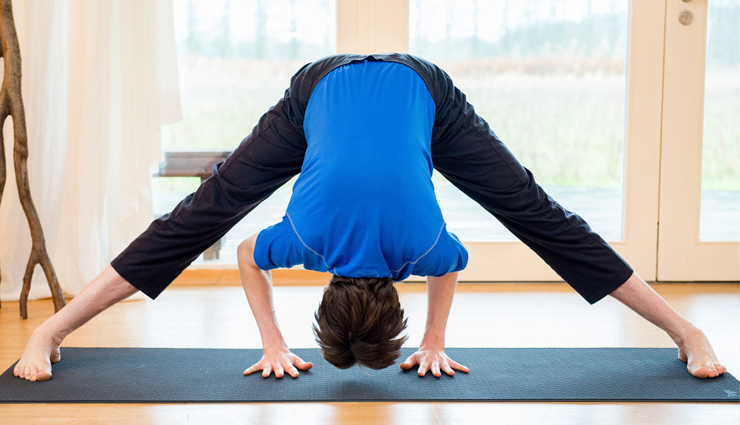
# Prasarita Padottanasana
Prasarita Padottanasana, also known as Wide-Legged Forward Fold, is a standing yoga pose that stretches the hamstrings, inner thighs, and lower back while promoting a sense of grounding and relaxation. Here's a step-by-step guide on how to practice Prasarita Padottanasana:
- Begin by standing at the top of your yoga mat with your feet wide apart. The distance between your feet should be approximately 3 to 4 feet, but you can adjust it according to your comfort.
- Turn your feet parallel to each other, so they are pointing straight ahead. Make sure your toes are pointing forward and the outer edges of your feet are parallel to the sides of your mat.
- Inhale deeply, lengthen your spine, and engage your abdominal muscles to support your back.
- As you exhale, begin to hinge forward from your hips, keeping your spine long and your chest open. Lead with your heart and maintain a flat back as you fold forward.
- Bring your hands to the ground directly below your shoulders, shoulder-width apart. If you have difficulty reaching the ground, you can place your hands on yoga blocks or any elevated surface.
- As you continue to fold forward, relax your head and neck, allowing them to hang naturally. Feel the stretch in your hamstrings, inner thighs, and lower back.
- You can keep your legs straight or slightly bend your knees if you feel any strain in your hamstrings. The focus is on maintaining a lengthened spine and finding a comfortable stretch.
- If it feels accessible, you can walk your hands back between your feet, deepening the stretch and allowing your head to move closer to the ground. However, only go as far as your body allows without strain.
- Stay in the pose for several breaths, allowing your body to relax and release tension. If you're comfortable, you can hold the pose for 30 seconds to a minute, gradually increasing the duration over time.
- To come out of the pose, engage your abdominal muscles, press through your feet, and inhale as you slowly rise back up to a standing position. Take a moment to notice the effects of the pose on your body.
Some additional tips for practicing Prasarita Padottanasana:
- If you have tight hamstrings or limited flexibility, you can modify the pose by placing your hands on yoga blocks or on a higher surface to bring the ground closer to you.
- Keep a slight micro-bend in your knees to protect your hamstrings and avoid hyperextension.
- Avoid rounding your back as you fold forward. Instead, focus on maintaining length and extension through your spine.
- If you experience discomfort or strain in your lower back, lessen the depth of your forward fold or seek guidance from a qualified yoga instructor.
- Remember to breathe deeply throughout the pose, allowing your breath to facilitate relaxation and release.
Practicing Prasarita Padottanasana regularly can help improve flexibility in the hamstrings, inner thighs, and lower back. It also helps to calm the mind and promote a sense of grounding. As with any yoga pose, listen to your body, modify as needed, and respect your limits. Enjoy the process of exploring this rejuvenating posture.
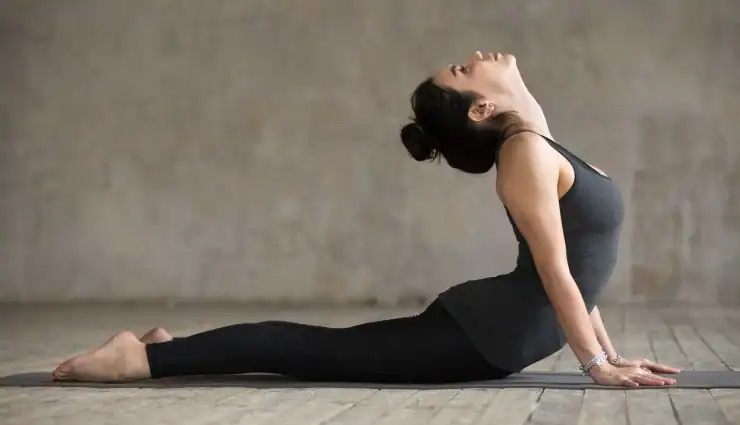
# Bhujangasana or Cobra Pose
Bhujangasana, also known as Cobra Pose, is a gentle backbend that stretches the spine, opens the chest, and strengthens the muscles of the back and arms. Here's a step-by-step guide on how to practice Bhujangasana:
- Start by lying flat on your stomach on a yoga mat or a comfortable surface. Place your palms on the mat, slightly below your shoulders, with your fingers spread wide and pointing forward. Keep your elbows close to your body.
- Position your legs hip-width apart, with the tops of your feet pressing into the mat.
- Take a deep breath in and, as you exhale, engage your core muscles and press your hands firmly into the mat. Begin to lift your head, chest, and upper abdomen off the ground, using the strength of your back muscles.
- Keep your pelvis grounded and your legs active, pressing the tops of your feet into the mat. Imagine lengthening your tailbone towards your heels to maintain a long, neutral spine.
- Avoid putting excessive weight on your hands. Instead, use your back muscles to lift your upper body, allowing your hands to provide support rather than bearing the entire weight.
- As you continue to rise, keep your gaze forward or slightly upward, without straining your neck. Find a comfortable position for your neck and maintain it throughout the pose.
- Take slow, deep breaths as you hold the pose. With each inhalation, lengthen your spine and lift a little higher. With each exhalation, relax any tension and find a comfortable stretch.
- Stay in the pose for about 15 to 30 seconds, or as long as feels comfortable for you. Avoid overextending your back or pushing beyond your limit. Remember to listen to your body and work within your own range of motion.
- To release the pose, exhale as you slowly lower your chest, abdomen, and head back down to the mat. Rest your forehead on the mat and relax your arms by your sides.
Some additional tips for practicing Bhujangasana:
- Keep your shoulders relaxed and away from your ears. Avoid scrunching your shoulders up towards your neck.
- As you lift your chest, imagine the movement initiating from the base of your spine and flowing upwards through each vertebra.
- If you experience any discomfort or strain in your lower back, modify the pose by keeping your elbows bent and your forearms on the ground, creating a Sphinx Pose variation.
- If you have a back injury or recent abdominal surgery, consult with a healthcare professional or a qualified yoga instructor before practicing Bhujangasana.
- Incorporate Bhujangasana as part of a well-rounded yoga practice, including warm-up stretches and counterposes to maintain balance and avoid overemphasis on one area of the body.
Bhujangasana is a wonderful pose for strengthening the back, improving posture, and increasing flexibility. With regular practice, it can help alleviate back pain and improve overall spinal health. Remember to approach the pose with mindfulness, honoring your body's capabilities and limitations.
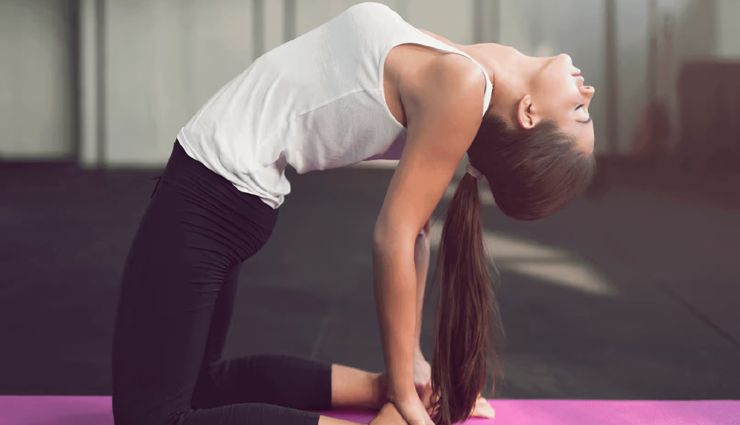
# Ustrasana or Camel Pose
Ustrasana, also known as Camel Pose, is a deep backbend that stretches the front of the body, opens the chest, and strengthens the back muscles. Here's a step-by-step guide on how to practice Ustrasana:
- Begin by kneeling on your yoga mat with your knees hip-width apart. Keep your thighs perpendicular to the mat and press the tops of your feet firmly into the ground.
- Place your hands on your hips, with your fingers pointing downward and your thumbs resting on your sacrum (the triangular bone at the base of your spine).
- Inhale deeply and lengthen your spine, engaging your core muscles.
- As you exhale, begin to lean back, keeping your chin slightly tucked. Start to slide your hands down the back of your thighs, reaching for your heels.
- Only reach for your heels if it feels comfortable for you. If you can't reach your heels, you can keep your hands on your hips or rest them on the lower back.
- Once your hands are in position, press your hips forward, arching your back and opening your chest. Lift your sternum upward while keeping your neck relaxed.
- If it feels accessible, you can drop your head back and gaze up toward the ceiling or sky. If that strains your neck, you can keep your chin tucked and gaze forward.
- Stay in the pose for several breaths, maintaining a steady breath. With each inhalation, lengthen your spine and lift your chest a little higher. With each exhalation, relax any tension and deepen the stretch.
- To come out of the pose, bring your hands back to your hips and slowly lift your torso back up to an upright kneeling position.
Some additional tips for practicing Ustrasana:
- If you have any neck or back injuries, or if you feel discomfort in your lower back, it's best to avoid or modify this pose. Consult with a healthcare professional or a qualified yoga instructor for guidance.
- Engage your core muscles throughout the pose to support your lower back and protect your spine.
- Take it slow and gradually increase the depth of the backbend over time. Avoid pushing beyond your comfortable range of motion or forcing yourself into a deeper backbend.
- If reaching for your heels is challenging, you can use yoga blocks or place your hands on the back of your pelvis as support.
- Listen to your body and honor your limits. It's normal to feel a stretch, but if you experience any sharp pain or discomfort, ease out of the pose.
- Incorporate Ustrasana within a balanced yoga practice, including warm-up stretches and counterposes to maintain balance and avoid overemphasis on one area of the body.
Ustrasana can be an invigorating pose that opens the front of the body, increases spinal flexibility, and promotes a sense of energy and vitality. With regular practice and proper alignment, it can provide numerous benefits. Remember to approach the pose mindfully, respecting your body's needs and limitations.
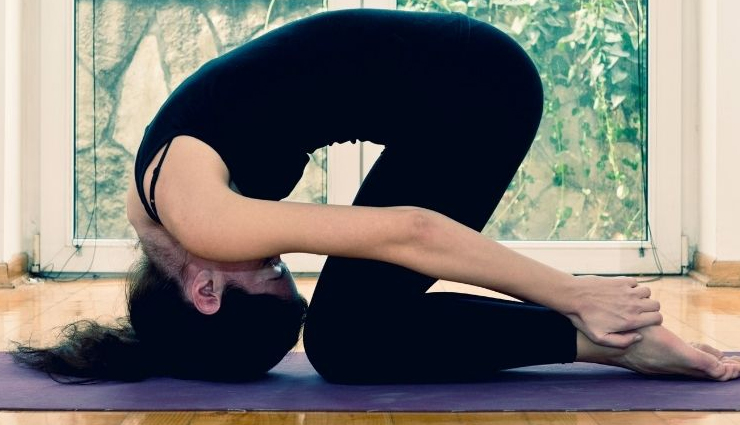
# Sasangasana or Rabbit Pose
Sasangasana, also known as Rabbit Pose, is a yoga posture that involves a forward bend with the head tucked under the body. It provides a gentle stretch for the spine, shoulders, and neck. Here's a step-by-step guide on how to practice Sasangasana:
- Begin by kneeling on your yoga mat with your knees hip-width apart. Keep your thighs perpendicular to the mat and press the tops of your feet firmly into the ground.
- Place your hands on your heels, with your fingers pointing toward your toes. If reaching your heels is challenging, you can use yoga blocks or a prop to support your hands.
- Inhale deeply and lengthen your spine, engaging your core muscles.
- As you exhale, begin to lower your head toward the floor, tucking your chin in toward your chest. Keep your neck relaxed and allow your forehead or the top of your head to touch or come close to the mat.
- While keeping your head down, start to walk your hands toward your feet, maintaining a grip on your heels or using the blocks as support.
- As you walk your hands toward your feet, allow your back to round and your spine to lengthen. Feel the stretch in your upper back, shoulders, and neck.
- Stay in the pose for several breaths, focusing on relaxing your neck and surrendering into the forward fold. Take slow, deep breaths, allowing your body to soften and release tension.
- To come out of the pose, release your hands from your heels or prop. Slowly lift your head and bring it back up to an upright kneeling position.
Some additional tips for practicing Sasangasana:
- If you have any neck or back injuries, or if you feel discomfort in your neck or spine, it's best to avoid or modify this pose. Consult with a healthcare professional or a qualified yoga instructor for guidance.
- Keep your breath steady and even throughout the pose. Use your breath to deepen the relaxation and release any tension in your upper body.
- If reaching your heels is challenging, you can modify the pose by placing your hands on the back of your thighs or lower back. Focus on the forward fold and the elongation of the spine.
- Remember to engage your core muscles to support your lower back and protect your spine as you fold forward.
- Take your time and be gentle with yourself. Allow your body to gradually open up and deepen into the pose over time. Avoid pushing or forcing yourself into an uncomfortable position.
- Incorporate Sasangasana within a balanced yoga practice, including warm-up stretches and counterposes to maintain balance and avoid overemphasis on one area of the body.
Sasangasana can provide a calming and grounding experience, promoting relaxation and gentle stretching for the upper body. Approach the pose with mindfulness and listen to your body's cues to find your own variation of the posture that suits your needs.
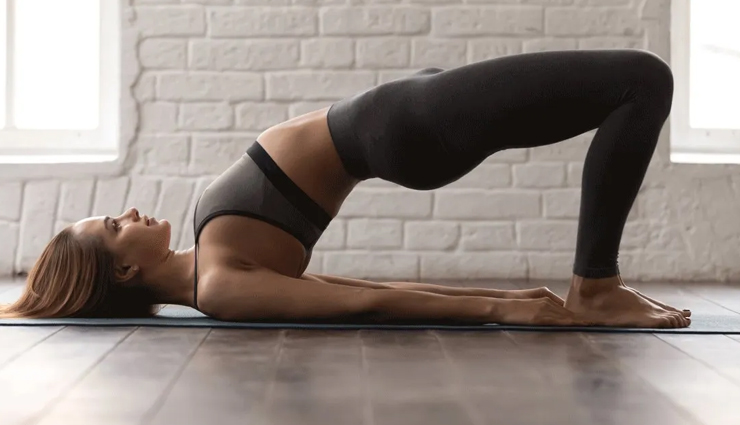
# Setubandhasana or Bridge Pose
Setu Bandhasana, also known as Bridge Pose, is a yoga posture that helps stretch the spine, open the chest, and strengthen the legs and glutes. Here's a step-by-step guide on how to practice Setu Bandhasana:
- Start by lying flat on your back on a yoga mat or a comfortable surface. Bend your knees and place your feet hip-width apart, flat on the ground, with your heels close to your sitting bones.
- Place your arms alongside your body, palms facing down. Ensure that your feet and knees are aligned with your hips.
- Inhale deeply and, as you exhale, press your feet firmly into the ground. Engage your core muscles and begin to lift your hips off the mat, lifting one vertebra at a time.
- Continue lifting your hips until your thighs are parallel to the mat. Keep your knees directly over your heels, and avoid letting your knees splay out to the sides.
- Roll your shoulders back and interlace your fingers underneath your body. Press your forearms into the mat and draw your shoulder blades together, creating space in your chest.
- Relax your neck and lengthen your chin slightly away from your chest. Keep your gaze upward or straight ahead, avoiding strain in the neck.
- Take slow, deep breaths as you hold the pose. With each inhalation, lift your hips a little higher, and with each exhalation, relax any tension in your body.
- Stay in the pose for about 30 seconds to a minute, or as long as it feels comfortable for you. Gradually increase the duration as you become more familiar with the posture.
- To come out of the pose, release your hands and gently roll your spine back down to the mat, lowering your hips down one vertebra at a time. Rest on your back and take a few breaths to notice the effects of the pose.
Some additional tips for practicing Setu Bandhasana:
- Ensure that your knees and feet are hip-width apart throughout the pose to maintain stability and alignment.
- Engage your glutes and leg muscles to support the lift of your hips. Avoid straining your lower back or over-arching the spine.
- If interlacing your fingers underneath your body is uncomfortable, you can keep your arms alongside your body with palms facing down.
- Modify the pose by placing a yoga block or a bolster under your sacrum for additional support and elevation.
- If you have any neck or shoulder issues, avoid putting excessive pressure on your upper body. Instead, focus on the lift of the hips and the opening of the chest.
- Incorporate Setu Bandhasana within a balanced yoga practice, including warm-up stretches and counterposes to maintain balance and avoid overemphasis on one area of the body.
Setu Bandhasana can be a rejuvenating pose that opens the chest, strengthens the legs, and energizes the body. Practice with mindfulness and listen to your body's feedback. As with any yoga posture, respect your own limitations and avoid pushing beyond your comfort zone.





